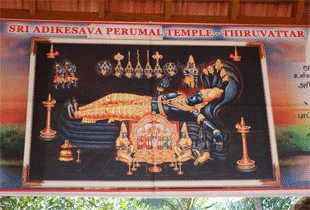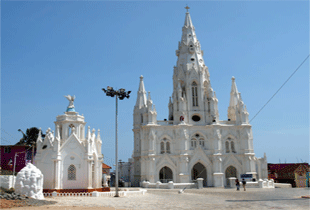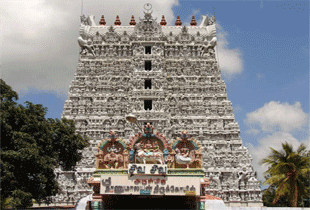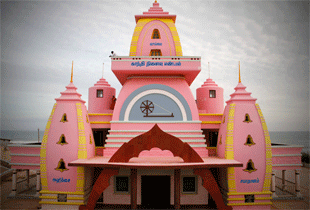Kanyakumari, India
Located on the southernmost tip of peninsular India and spread over an area of 1672 km², Kanyakumari interweaves a mysterious charm in each part of this destination. Travelers visit this mesmerizing place to access its natural beauty that is enriched with brilliance of splendid sunrise and soft sunset simmering over the confluence of three oceans - the Bay of Bengal, the Arabian Sea and the India Ocean. With multi-colored sand on beaches, Kanyakumari also features twist of majestic hills along with swaying coconut trees and copious farms. It is full of red cliffs and charming valleys and features several temples and churches that enrich the echoing magnificence of the place.
Kanyakumari is a significant Hindu pilgrim center, which is visited by a number of devotees from all over the country. While digging into Kanyakumari's history, one may find that the place happened to be onetime Alexandria of the east. Various dynasties like the Cholas, the Cheras, the Pandyas and the Nayaks contributed seriously to the architectural marvels of the region. The place has also served as a hub of art, culture, and civilization. It is likewise recognized for commerce and trade. Along with natural beauty, Kanyakumari is known for its architectural beauty that is inspired by religions like Islam, Christianity and Jainism. Tourists visiting this charming destination can explore here numerous tourist attractions.
Visit in Kanyakumari
With vast stretch of azure sky over the incredible convergence of three oceans - the Bay of Bengal, the Indian Ocean and the Arabian Sea, Kanyakumari offers the mesmerizing views of nature. Along with beach beauty and marine splendor, Kanyakumari bestows a host of tourist spots that people can visit on their Kanyakumari trip. Here below is the list of important places to visit in Kanyakumari.
The church is one among the places of interest in Kanyakumari. The church was built in the Gothic style and has a strong Portuguese influence on its architecture. The church was designed in 15 the century A.D. Our Lady of Ransom Church is an important attraction in the Kanyakumari; this church is first of its kind here. The height of the church is about 154 feet, width of 52 feet and a position of 54 feet above land level. The Central Tower is crowned with a Cross of pure gold. It is a must visit attraction in Kanyakumari.
Vivekananda Rock Memorial is situated in the midst of the ocean over a rock, just 390 meters from away from the mainland. The memorial is dedicated to Swami Vivekanand – a great social reformer of India. It was built in the year 1970, under the guidance of Shri Eknath Ranade. Swami Vivekananda came to Kanyakumari on 1892 and he meditated on the rock for seeking enlightenment for two days in 1893 before proceeding to Chicago. The opens from Wednesday to Monday and remains closed on Tuesday.
Located close to Kumari Amman Temple, Gandhi Mandapam is one of the famous places to see in Kanyakumari. It is also known as Gandhi Temple and famous for its cultural richness and significance. The temple was built in the year 1956 in memory of Mahatma Gandhi. After the death of Gandhi, his body ashes disposed in the sea of Kanyakumari. The memorial is built at the place where his ashes were dispersed.
Padmanabhapuram Palace is one of the finest architectural marvels of Kanyakumari and the best places to visit near Kanyakumari. It was built in 1601 A.D by the great Iravivarma Kulasekhara perumal who ruled Travancore between 1592 A.D. and 1609 A.D. It is situated at around 44 km away from kanyakumari. This beautiful palace is surrounded by a fort and spread over an area of 188 acres. Its sheer aesthetic beauty, innovative designs, murals, carvings and sculptures are the main appeal of the palace.
Suchindram Temple is one among the nearby tourist places in Kanyakumari, which is situated at a distance of 14 km from Kanyakumari. This temple is dedicated to Siva, Vishnu and Brahma. There is a huge 18 feet idol of Hanuman on the right side of the main gate. The temple is also known as Sthanumalayan Temple and noted for its wonderful architecture and sculptures. It is a brilliant architectural triumph, recognized for its excellence of workmanship in stone. There are four musical pillars made using a single stone. The pillars radiate a variety of musical notes.
It is a 133 feet tall stone sculpture of the eminent Tamil poet and philosopher Tiruvalluvar. Situated on the top of a small island close to Kanyakumari on the southernmost Coromandel Coast, it is an important sightseeing place in Kanyakumari. The statue is 95 feet high and positioned on a 38-foot pedestal that represents the 38 chapters of the Thirukkural.
It is one of the oldest temples in this region. The main deity of the temple is Lord Shri Padmanabha swamy. The architecture of the temple is built in Dravidian style with wooden pillars, doors and roofs. The main deity of the temple is lying on his snake couch. The temple is located 45 km away from Kanyakumari.
Located in Attoor village of Kanyakumari district, it is an important shrine of Ayya Vaikundar who is supposed to be an incarnation of Lord Narayana. The main feature of the temple is its unique architectural style called Sahasrara (literal meaning white lotus). It is the first temple to possess Sahasrara architecture.
Kanyakumari Beach is a breathtaking destination featuring vibrant sand. The beach is bumpy and stony but it enhances the beauty of the beach. There is a lighthouse on the shore of this beach offering panoramic views of the area.
Overlooking the shoreline, Kanyakumari Temple is one of the best places to visit in Kanyakumari. The temple is dedicated to Devi Kumari Amman (Parvati) - a virgin incarnation of Goddess Durga, who wanted to marry Lord Shiva. The temple has the black stone image of the virgin deity with a diamond nose ring glittering in the dark chambers. The goddess of the temple is respected as 'the protector of India's shores'. The temple opens for the devotees and tourists in the early morning between 04:30 am and 11:30am and in evening between 5:30pm and 8:30pm. The main entrance of the temple is through the northern gate and non Hindus are not allowed inside.
Kanyakumari, India

March to Mid-June, warm and humid
Temperature:38°C – 45°C

July to October
Annual rainfall -1300 mm

Last November to February, Cool and Pleasant
Temperature:18°C – 25°C
Sights of Kanyakumari



